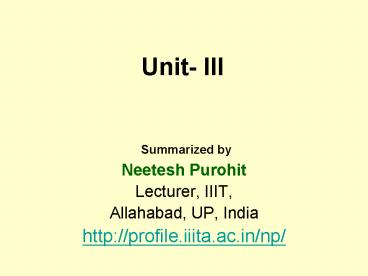Summarized by - PowerPoint PPT Presentation
1 / 16
Title:
Summarized by
Description:
Filtering of long data Sequence (overlap-save and overlap-add method) Windowing technique (leakage effects ... Radix-r algorithms. Decimation-in-time algorithm ... – PowerPoint PPT presentation
Number of Views:53
Avg rating:3.0/5.0
Title: Summarized by
1
Unit- III
- Summarized by
- Neetesh Purohit
- Lecturer, IIIT,
- Allahabad, UP, India
- http//profile.iiita.ac.in/np/
2
Some Applications of DFT
- Linear Filtering methods based on DFT
- Filtering of long data Sequence (overlap-save and
overlap-add method) - Windowing technique (leakage effects and spectral
resolution)
3
Fast Fourier Transform
- In 1967 calculation of a 8192-point DFT on the
top-of-the line IBM 7094 took . - 30 minutes using conventional techniques
- 5 seconds using FFTs
- Divide and conquer approach
- Radix-r algorithms
4
Decimation-in-time algorithm
- Consider the FFT algorithm for an integer power
of 2, - Create separate sums for even and odd values of
n - Letting for n even and
for n odd, we obtain
5
Using following Properties of W-function
and
The DFT
F1(k) WNkF2 (k)
Have we gained anything? for N8 direct
computation will require (8)2 64
multiplications After decimation No of
multiplications (4)2 (4)2 8 40
X(k) F1(k) WNkF2 (k) and X(kN/2) F1(k) -
WNkF2 (k) (prove it)
X (r)
F1 (r)
F2 (r)
X (rN/2)
6
Same butterfly is applicable for evaluating two
point DFT
Complete Butterfly diagram for 8-point FFT
X07
x0
x4
x2
x6
x1
x5
x3
x7
7
Decimation in frequency
Divide x(n) from middle
Decimate in frequency
8
(No Transcript)
9
Use of FFT in linear filtering and correlation
- An assignment
10
Quantization effects in the computation of DFT
- In hardware the register length is fixed to some
value (b bits) - Multiplication of two b bit data may produce
2b bit data. - The truncation/rounding off of 2b bit data to
b bit data produces quantization errors.
11
- Assuming that quantization error is uniformly
distributed, the variance of error after a single
multiplication will be - s2e S2/12 S is step size.
- With b bits q2b levels can be represented thus
step size (S) 1/q 2-b - In Direct Computation, 4N real multiplications
are required to evaluate one point of an N point
DFT. - The variance of quantization error s2q 4N s2e
- For N2v s2q 2-2(b-v/2)/3
- Every 4 fold increase in N requires one more bit
to offset the additional quantization error.
12
Quantization errors in FFT
- Each butterfly computation involves 1 complex
i.e. 4 real multiplications, thus - s2q 4Z s2e
- Where, Z The number of butterflies that affect
the computation of any one value of DFT. - In general Z N/2N/4N/8..21 2v (appx) N
- FFT does not reduce the quantization error.
13
The scaling factor
- If X(k) gt1 it results in overflow (no register
can store a magnitude greater than unity) - Direct computation the upper bound is
- X(k)lt ?(0 to N-1)x(n) (As W cant be gt1)
- RHS lt1 if all samples are divided by N thus range
of input (-1/N to 1/N) and S2/N - Variance of Input signal sequence x(n)
- s2x (2/N)2/12 1/3N2
- Variance of O/P signal sequence X(k)
- s2X Ns2x 1/3N (each X(k) depends upon all N
points of x(n)) - SQNR s2X/ s2q
14
- In FFT, scaling can be done after each stage.
- Maximum O/P value from a butterfly lt twice the
maximum I/P value - Thus a scaling factor (½) is used after each
stage. - There are v steps thus signal will experience
(1/2)v 1/N (same scaling) - The scaling of quantization error from previous
stage greatly improves the performance. - It can be shown that
- s2q 2/3(2-2b)
15
Limitations of Fourier tools
- Zero time resolution in frequency domain
16
The Wavelet Transform
- Continuous time
- Discrete time
- Applications































